In system design interviews and real-world architecture planning, the ability to make quick, reasonably accurate estimations—often called “back-of-the-envelope” calculations—is an invaluable skill. These calculations help you determine whether a proposed design is feasible, identify potential bottlenecks, and make informed architectural decisions without getting lost in implementation details.
Why Back-of-the-Envelope Calculations Matter
Back-of-the-envelope calculations serve several critical purposes in system design:
- Feasibility Assessment: Quickly determine if a proposed solution is viable before investing in detailed design
- Resource Planning: Estimate hardware, network, and storage requirements
- Bottleneck Identification: Discover potential performance limitations early
- Cost Estimation: Approximate infrastructure and operational costs
- Capacity Planning: Ensure the system can handle expected load and growth
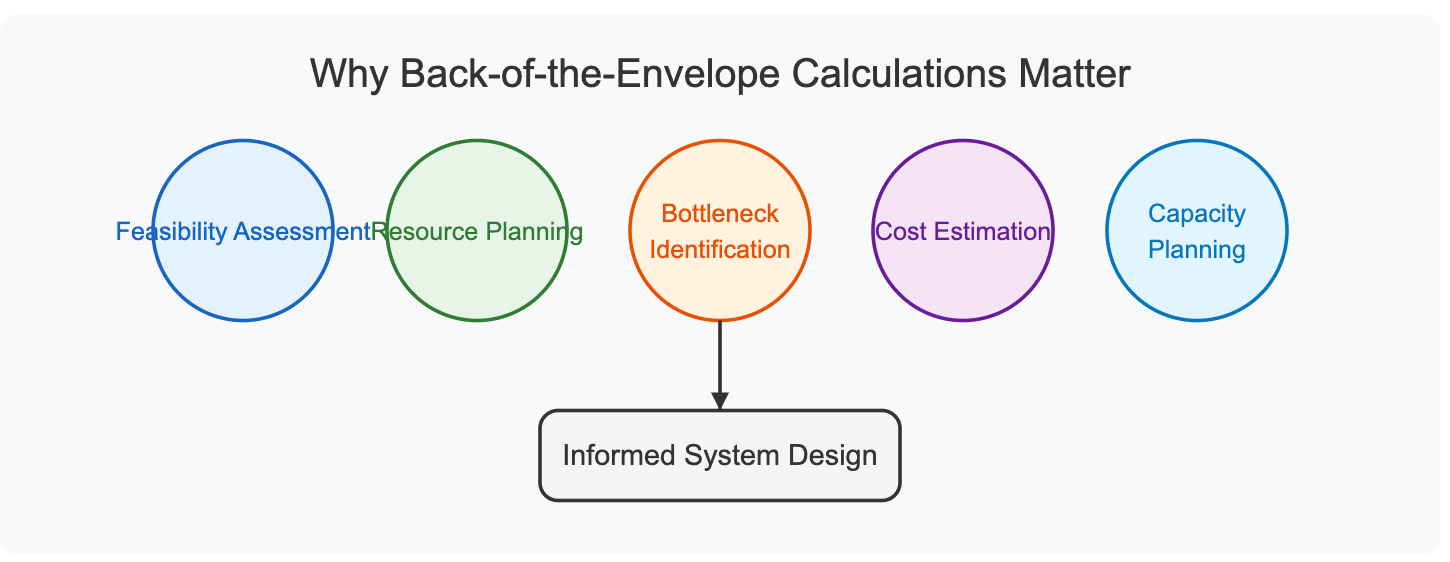
Essential Numbers to Memorize
To perform back-of-the-envelope calculations effectively, you should memorize certain key values. Here are the most important ones:
Time-Related Constants
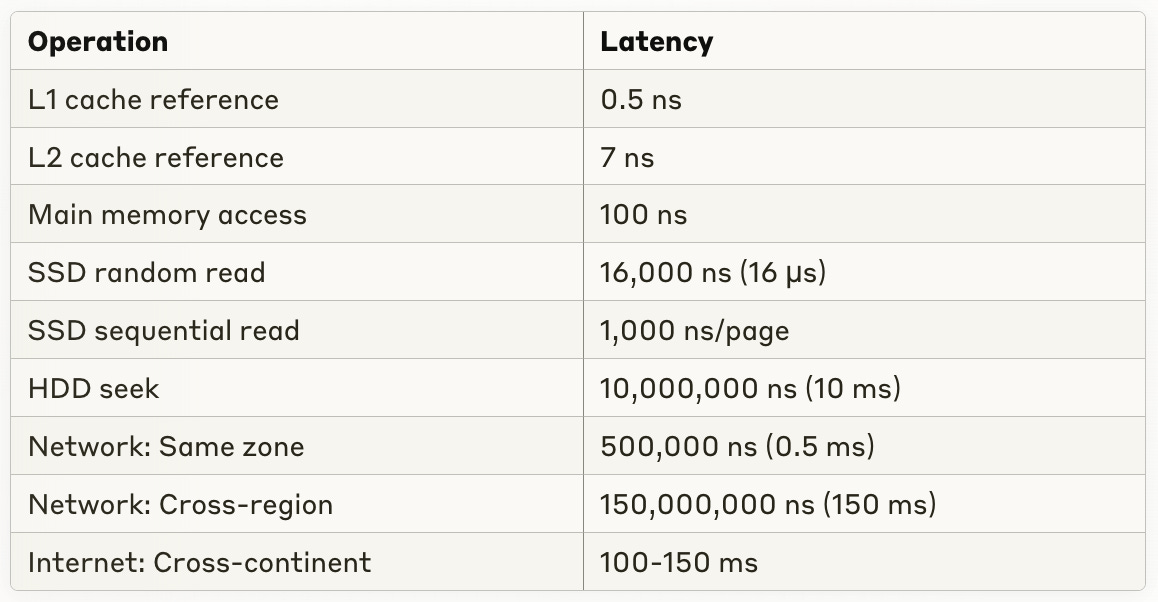

Storage and Data Transfer

Common Web Application Numbers
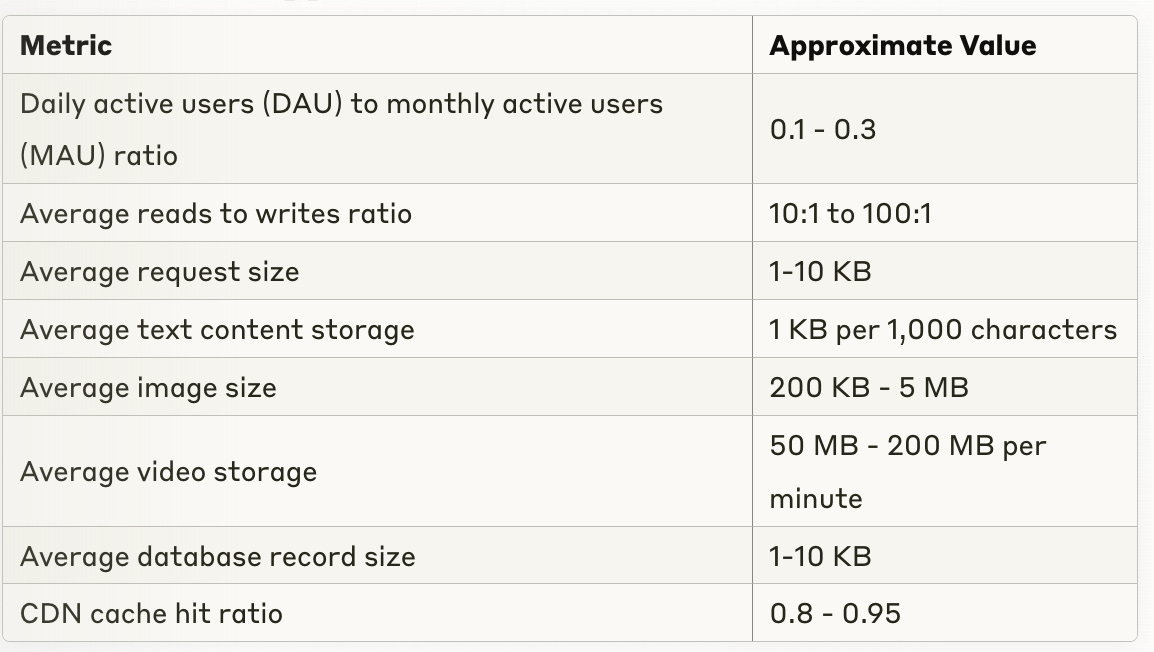
The Art of Estimation: A Step-by-Step Approach
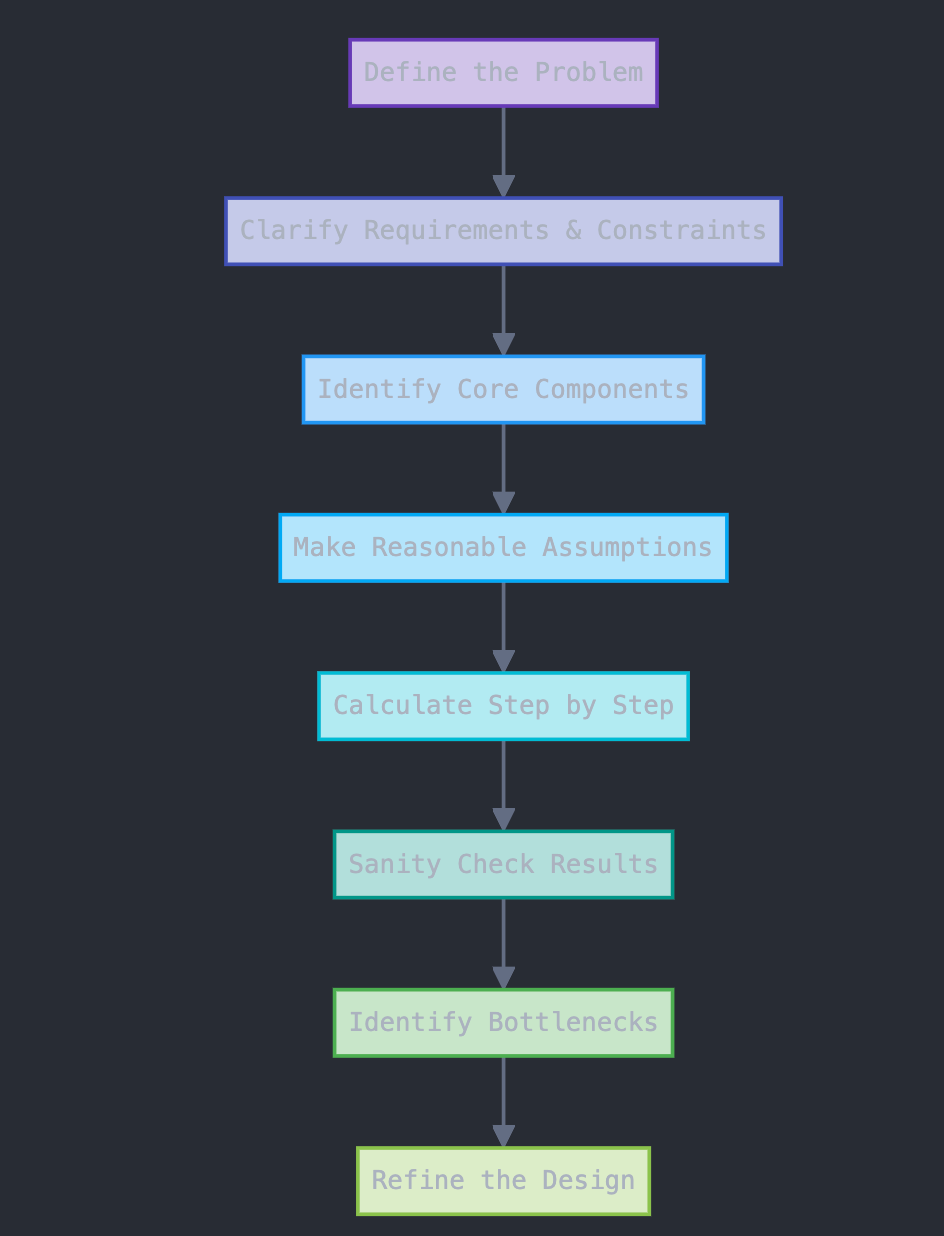
1. Define the Problem Clearly
Begin by understanding what you’re estimating. Is it storage requirements, QPS (queries per second), bandwidth, or something else?
2. Clarify Requirements and Constraints
Identify key metrics like:
- Number of users (daily/monthly active)
- Expected request rates
- Data storage needs
- Latency requirements
- Availability expectations
3. Make Reasonable Assumptions
Document your assumptions clearly. For example:
- Average user session duration
- Read-to-write ratio
- Data growth rate
- Peak-to-average traffic ratio
4. Break Down the Problem
Divide complex estimations into smaller, manageable calculations.
5. Apply Power-of-Ten Approximations
Round numbers to simplify calculations (e.g., use 10^6 instead of 1,234,567).
6. Verify with Sanity Checks
Double-check results against known benchmarks or real-world examples.
7. Identify Potential Bottlenecks
Use your calculations to spot system limitations.
Example 1: URL Shortener System
Let’s estimate storage and QPS requirements for a URL shortener service like bit.ly.
Step 1: Define Requirements
We need to estimate:
- Storage requirements for URLs
- QPS the system must handle
- Bandwidth requirements
Step 2: Make Assumptions
- Traffic assumptions:
- 100 million URLs shortened per month
- Read-to-write ratio: 10:1 (10 URL accesses for each new shortened URL)
- Storage assumptions:
- Original URL average length: 100 characters (100 bytes)
- Shortened URL length: 7 characters (7 bytes)
- Metadata per URL: 50 bytes (timestamps, user ID, etc.)
Step 3: Calculate QPS
New shortened URLs per month: 100 million
- Per day: 100 million / 30 ≈ 3.33 million
- Per second: 3.33 million / 86,400 ≈ 39 URLs/second
URL redirections (reads) per second: 39 × 10 = 390 URLs/second
Total QPS: 39 + 390 = 429 QPS (writes + reads)
Peak QPS (assuming 2× peak factor): 429 × 2 ≈ 858 QPS
Step 4: Calculate Storage Requirements
Storage per URL: 100 bytes (original URL) + 7 bytes (shortened URL) + 50 bytes (metadata) = 157 bytes
Monthly storage growth: 100 million URLs × 157 bytes ≈ 15.7 GB/month
5-year storage requirement: 15.7 GB × 12 months × 5 years ≈ 942 GB
URL Shortener Estimation
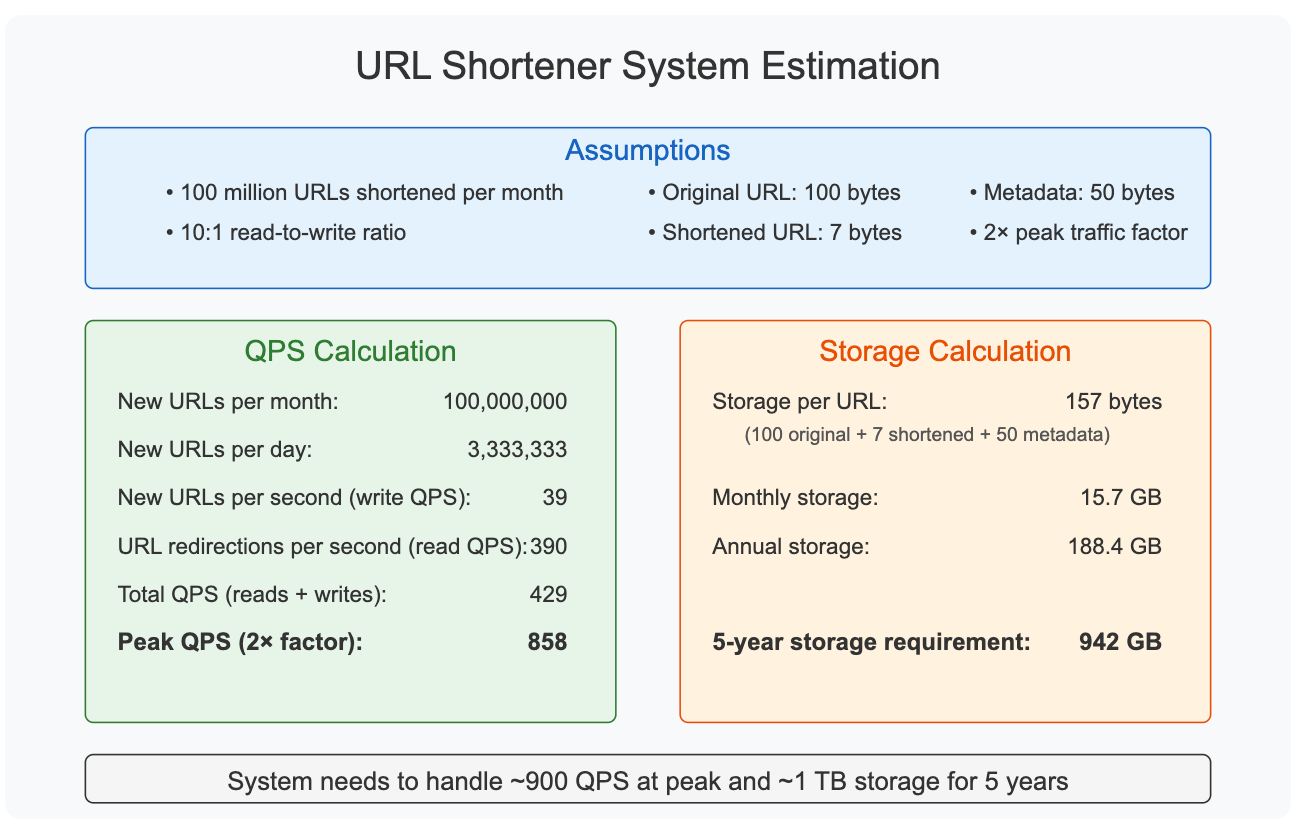
Step 5: System Implications
Based on our calculations:
- QPS requirement (858 at peak) can be handled by a single modern application server
- Storage requirement (~1 TB) is modest and can be handled by a single database server
- We should consider sharding if we expect significant growth beyond our estimates
Example 2: Video Streaming Platform
Let’s estimate storage and bandwidth requirements for a YouTube-like video streaming service.
Step 1: Define Requirements
We need to estimate:
- Daily storage requirements for new videos
- Bandwidth requirements for streaming
Step 2: Make Assumptions
- Traffic assumptions:
- 100 million daily active users (DAU)
- 5% of users upload a video daily
- Average user watches 10 videos per day
- Average watch time: 70% of video length
- Video assumptions:
- Average video length: 5 minutes
- Average video size: 50 MB per minute (multiple resolutions)
- We store 3 resolutions of each video (HD, medium, low)
Step 3: Calculate Storage Requirements
Number of videos uploaded daily: 100 million × 0.05 = 5 million videos
Average video size: 5 minutes × 50 MB/minute × 3 resolutions = 750 MB per video
Daily storage required: 5 million × 750 MB = 3,750 TB (3.75 PB) per day
Annual storage growth: 3.75 PB × 365 = 1,368.75 PB (1.37 EB) per year
Step 4: Calculate Bandwidth Requirements
Views per day: 100 million users × 10 videos = 1 billion video views
Average data per view: 5 minutes × 70% × 3 MB/minute = 10.5 MB per view (assuming average streaming quality is about 3 MB/minute)
Daily bandwidth: 1 billion × 10.5 MB = 10.5 PB per day
Peak concurrent users: 10% of DAU = 10 million users
Peak bandwidth (assuming equal distribution): 10 million × 3 MB/minute = 30 TB/minute = 500 GB/second
Video Platform Requirements
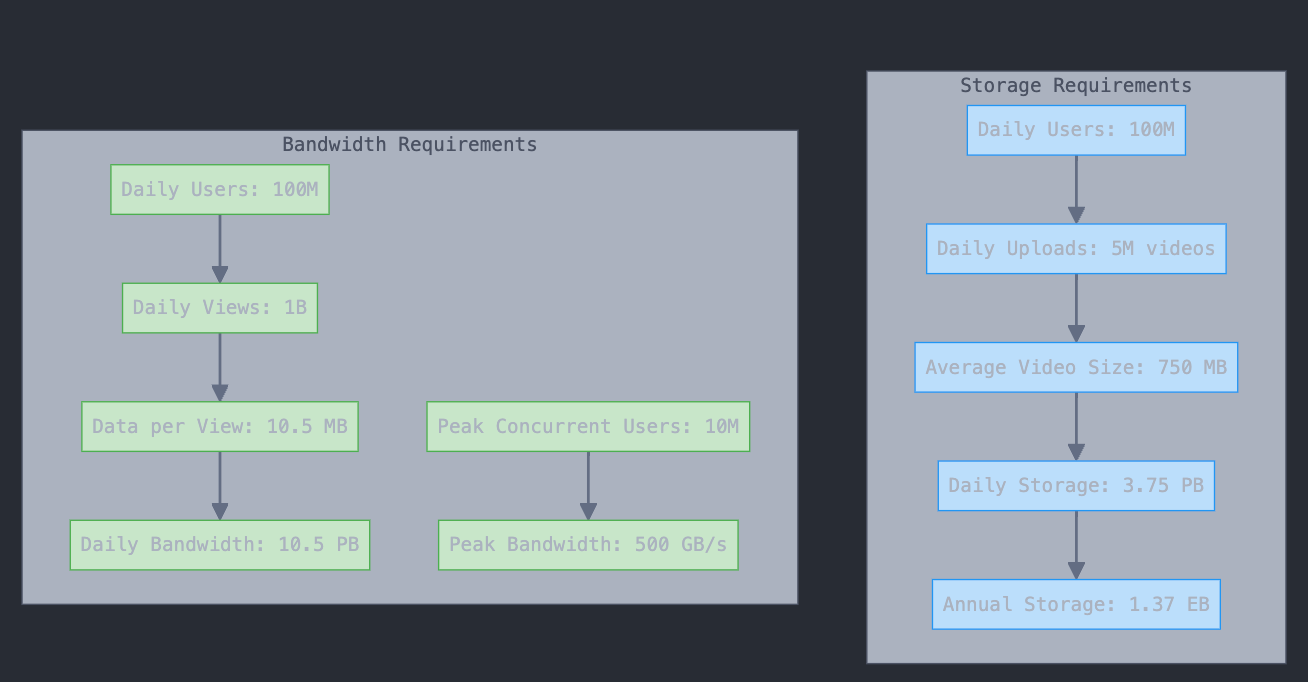
Step 5: System Implications
Based on our calculations:
- Storage requirements are massive, requiring a distributed storage solution
- Bandwidth requirements demand a global CDN infrastructure
- Cost considerations suggest the need for efficient video compression and storage optimization
Common Estimation Scenarios
Here are several common estimation scenarios you might encounter in system design interviews:

